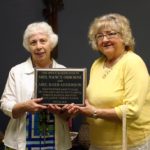By Patrick Schmadeke
Participants in listening sessions conveyed a mostly positive experience of the diocesan Synod, which sought to hear their experiences of the Catholic Church. However, some expressed twin concerns. First, a concern that the Synod will change doctrine. Second, that some will try to shoehorn in doctrinal change. Both concerns miss the point of the Synod but raise the interesting question about how doctrine changes over time.

One of the most difficult periods in the Church grappled with our modern understanding of history. Many developments in the Church from the mid-19th through 20th centuries resulted from bringing the study of history to bear on religious practice.
For example, the Church celebrated the feast of St. Christopher, often shown carrying the infant Christ on his shoulders across a river, on July 25 in the liturgical calendar. In 1970, the Church dropped St. Christopher from the calendar because history revealed that Christopher is a figure of legend.
Our sentimental attachment to such stories can cause us disappointment or frustration when we learn they have no historical basis. Stories like this are sweet and meaningful. Can we just let them be while still taking historical facts seriously? Catholicism is a historical religion, rooted in the fact that Jesus was a historical person. Catholics cannot ignore history.
To learn about the development of doctrine, we must ask, “What do we really believe?” Revelation comes from God and is carried forward in Scripture and tradition. Doctrine tries to define the essential truth that revelation teaches us. Doctrine emerges in our struggle to understand revelation and apply it to our living community.
Speaking broadly, doctrines can emerge from the pews, which we call the sensus fidei. Theologians examine it, ask questions about it and examine historical data. Bishops and the pope exercise teaching authority and determine how the doctrine is stated in such a way that it resonates with the experience of the faith community as it engages in an ongoing dialogue with Scripture and tradition. The faith community, after all, is the bearer of meaning through generations. The process comes full circle.
Doctrine develops as the community of faith struggles to develop its understanding of Christ’s command to love. Consider these developments: we were born from the storytelling culture of Judaism, which gave us the Bible. Then we grew into the philosophical culture of Greece, which produced the technical language of the creed.
The notion of “Christendom” emerged from the Holy Roman Empire. The medieval culture that followed blended the philosophy of Greece and the religio-political image of Christendom. The Renaissance gave us spiritual expressions: Michelangelo’s Pieta, da Vinci’s Annunciation and Botticelli’s Madonna. In an age of exploration, we had to express faith in terms that would resonate with newly discovered cultures. The Industrial Age witnessed the birth of Catholic Social Teaching in response to the rise of socialism and unbridled capitalism. Now, in an age of globalism, we ask, “Who is made in the image and likeness of God?” To which we respond: “Everyone.”
This leads us to see, acknowledge and respond to Christ in ever-wider circles of diversity. This brief survey of history suggests that religious doctrines and practices emerge in response to specific cultural contexts. Had we retained only the storytelling culture that gave us the Bible, we would never have come to the description of God as “Trinity.” In our age, we have discovered that doctrines are contingent — they derive from faith seeking understanding within any given culture.
Doctrinal development is something akin to faith development. A child who believes God will keep their loved ones safe has a stable worldview, which is called into question when a beloved grandmother, for instance, gets sick and dies. A new, resurrected faith is born from that experience. Analogously, doctrines that once served us well may face challenge because of dramatic historical changes, resulting in revision to those doctrines. The stunning images from the James Webb telescope cause us to look ever more closely into the mind of God. They inspire us to reexamine who God is and who we are in relationship to God.
The twin concerns mentioned at the outset of this article fundamentally misunderstand the Synod and Church history. If we are honest with ourselves, in the context of doctrine, we are still trying to figure out how to love our neighbor. Now, as always in our history, we must let our hearts desire the heart of Christ.
(Patrick Schmadeke is Director of Evangelization for the Diocese of Davenport.)











